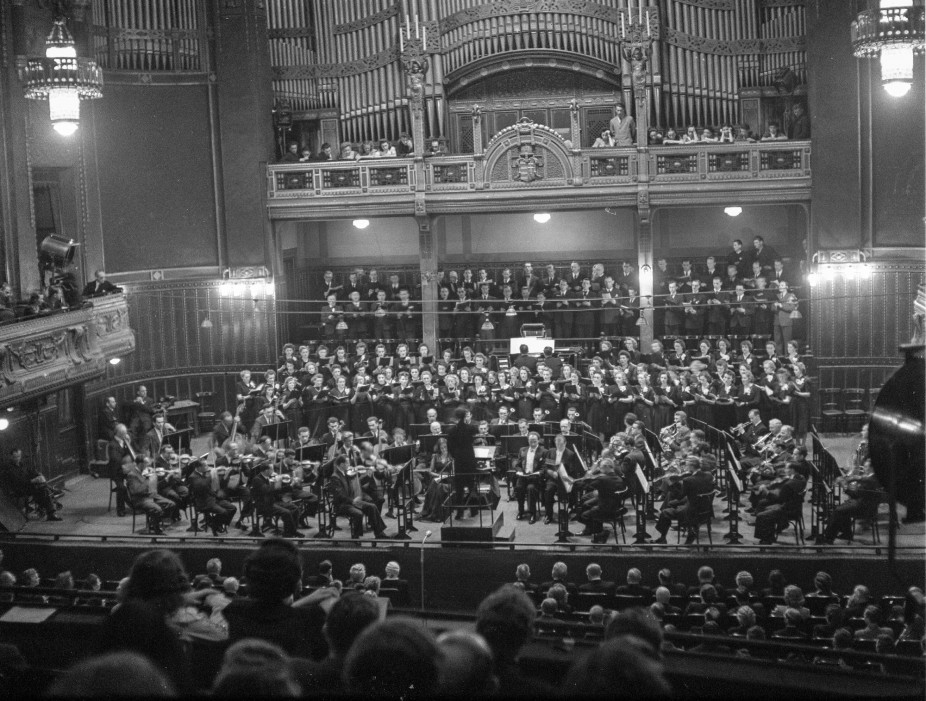The organs of the Grand Hall
I. The Voit-organ (1905–1967)
On 21 August, 1905, the German Voit & Söhne organ building company was contractually commissioned by the Liszt Academy to build a four-manual, 74-stop pipe organ. The roughly 23-ton heavy cargo was delivered by rail to Budapest and was handed over to the operation manager of the company, Oskar Binder in Budapest on 7 January, 1907. It was also him who later coordinated the installation process of the organ. The instrument was first played by Dezső d’Antalffy (born Dezső Antalffy-Zsiross) on 15 May, 1907, who performed Franz Liszt’s Prelude and Fugue on B-A-C-H in his own rearrangement. Between 1907 and 1925, the instrument energised the entire organ scene in Hungary allowing such renowned organists to play it as Karl Straube, the organist of the St Thomas Church in Leipzig or Alexandre Guilmant, the director of the Conservatoire de Paris or Enrico Bossi, one of the greatest organ-virtuosos of his time.
The first modifications were carried out because of some new artistic requirements in 1910, but the later rebuilding works were also technologically justified, as in the Grand Hall there had been climatic problem right from the very beginning. The organ had become virtually unusable by the 1920s, so the Pécs-based Angster Organ Company was commissioned to rebuild the complete structure of the instrument in 1924-25, but then in 1934, the Budapest-based Rieger Organ Company took over this responsibility. The serious injuries suffered during the second war were mended, but because of the insufficient resources available and the war losses of the organ factory, not all issues could be entirely remedied, thus the instrument remained in a critical condition. A complete structural and dispositional reconstruction in Neo-Baroque style seemed to be the only solution was carried out from 1948 till 1956. The pedalwork and the Great organ were rebuilt, while the pneumatic valve chests were turned into cone chests. In 1952, Rieger became state-owned in the Communist era, and its legal successor, the organ factory of the Municipal Craft Company- FMKV got in charge of the maintenance and reconstruction work of the instrument.
II. The Walcker-organ (1967-2011)
Due to the low-quality reconstructions, the organ failed to work reliably, thus in 1963, the plan of building a completely new organ arose. A new, „modern” concert organ seemed to the path to follow, so the German Walcker Organ Company was commissioned by the Liszt Academy in 1966 to carry out the task. The remains of the Voit-organ were disassembled and divided into two parts in 1967; only the façade remained in the Grand Hall hosting the new, 86-stop, four-manual Walcker-organ behind its pipes.
The further fate of the Voit-organ was as follows: Organs of two Hungarian towns received the rest of its parts: the organ in the Liszt Ferenc Hall in Sopron, and that in the assembly hall of Győr’s Town Hall. Both instruments were reconstructed in the decades to come: initially, both organs in Győr and Sopron were maintained by the same organ-builder, István Szakács, during whose activity a significant part of the pipe ranks suffered harm. In 1998, the organ in Sopron was decomposed and her parts were discarded alongside the construction waste. The organ builder, Péter Takács cherry-picked some of the more valuable pipes and made a new, small organ utilising them. The instrument in Győr also faced serious loss during a reconstruction process in 1998. She was then completely disassembled by the AerisOrgona Ltd under the professional guidance of Balázs Szabó in October, 2011. Thankfully, the city of Győr made it possible that the orginal parts were returned to the Liszt Academy.
As to the Walcker-organ: The installation of the new instrument that replaced the Voit-organ in 1967 lent a new impetus to the Hungarian organ scene. The Walcker-organ was a modern, contemporary instrument both in the use of materials and in intonation. The many various kinds of experimental materials, especially the different types of plastic and sealing materials and technologies traditionally not applied in organ building such as pipes made with plywood – did actually resist the climatic extremes of the Grand Hall but resulted in a recession in sound and in artistic quality, which then often brought about criticism. During the reconstruction work on the Main Building of the Liszt Academy in October, 2011, the Walcker-organ was finally pulled down.



